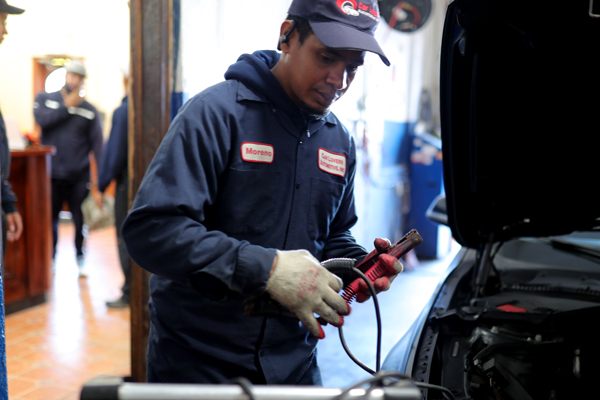All Categories
Featured
Proper tire upkeep is essential to prolonging the life of your car and ensuring a smooth and secure driving experience. Two of the most crucial tire solutions are tire turning and positioning. These solutions not just prevent premature tire wear however also boost handling, gas effectiveness, and overall safety. If you're unknown with what tire rotation and alignment entail, here's a thorough check out why they matter and exactly how they benefit your car.
What Is Tire Rotation? Tire rotation describes moving your tires from one position to another to guarantee they use evenly. The factor tire turning is required is because not all tires use the same way. In front-wheel-drive vehicles, for instance, the front tires handle both guiding and power, that makes them break faster than the back tires. Likewise, the back tires wear differently in rear-wheel-drive and all-wheel-drive automobiles.
By turning your tires regularly, you can cancel the wear across all four tires. This assists them last much longer and permits even more also grip, enhancing handling and security. A lot of manufacturers recommend revolving your tires every 6,000 to 8,000 miles or according to the automobile's guidebook.
What Is Tire Placement? Tire placement, likewise known as wheel placement, refers to the procedure of readjusting the angles of your cars and truck's wheels to fulfill the maker's specs. The objective of positioning is to make sure that all four tires are pointing in the right direction and at the proper angles, which enables ideal handling, safety, and tire life.
There are 3 primary alignment angles that are changed during an alignment check:

Camber: The tilt of the wheels when watched from the front. If the camber is off, it can cause irregular tire wear, as the tire will not make full call with the roadway surface. Caster: The angle of the steering axis when watched from the side. Correct caster positioning ensures that your lorry is steady when driving straight and that your wheel returns to its typical setting after a turn. Toe: The angle at which the tires direct inward or outward when seen from above. Inaccurate toe placement can trigger the tires to drag, causing uneven wear and reduced fuel performance. Imbalance can happen with time due to normal driving or from hitting challenges like curbs or holes. If your positioning is off, it is necessary to obtain it examined and remedied to prevent issues down the road.
Why Tire Turning and Placement Matter. Boosted Tire Life:. Regular tire rotation makes certain even tire wear, helping you obtain the most mileage out of your tires. Irregular wear can create you to replace tires too soon, which can be expensive. When your tires wear evenly, they last longer, saving you cash in the long-term.
Enhanced Lorry Handling:. Appropriate positioning keeps your car driving straight and secure, particularly at greater speeds. Misalignment can cause your vehicle to draw to one side, making it more challenging to guide. By keeping your tires aligned, you guarantee your automobile manages extra smoothly and naturally.
Enhanced Safety:. Tires that are not revolved or aligned appropriately can wear unevenly, impacting exactly how well your car quits and corners. Misaligned tires or tires with irregular wear patterns may trigger minimized traction, particularly in damp or icy conditions, leading to a higher danger of accidents.
Much Better Gas Effectiveness:. Tires that are misaligned can create rolling resistance, implying your engine needs to function more difficult to relocate the auto. This raises fuel usage and minimizes your vehicle's fuel performance. Proper tire alignment minimizes rolling resistance, which can boost gas mileage.
Indicators Your Tires Required Turning or Positioning. While it's essential to remain on top of regular tire rotations and placements, there are a few indicators that might indicate your tires require attention:
Unequal Use: If you notice that a person tire is a lot more worn than the others, it's most likely time for a turning. Steering Pull: If your car pulls away or feels off-center, it can be an indication of misalignment. Vibrations: If you really feel vibrations in the guiding wheel or the automobile, it can be as a result of an alignment problem. Noisy Tires: Screeching or loud tires could suggest improper rotation or imbalance. If you notice any of these indicators, it is very important to get your tires inspected by a professional.
How Typically Should You Turn and Straighten Your Tires? Tire rotation ought to generally be done every 6,000 to 8,000 miles, though this can differ based on your driving problems and the type of automobile you drive. It's additionally a good concept to have your tires rotated whenever you get an oil adjustment.
For placement, you must have your tires aligned every 1-2 years, or much more often if you observe any kind of issues with dealing with or unequal tire wear. If you struck a large split or curb, it's important to get an alignment inspect right away.
Conclusion: Normal Upkeep for Optimum Efficiency. Tire turning and positioning are two simple yet important solutions that keep your auto running efficiently, effectively, and safely. By turning your tires routinely and maintaining your wheels properly straightened, you can expand the life of your tires, enhance handling, and delight in better gas effectiveness.
Latest Posts
Reputable Expenses Door Solutions for Houses and Organizations
Discover Oil Changes & More: Complete Auto Care Solutions from Montclare Auto Repair
How Regular Auto Maintenance at Montclare Auto Repair Reduces Costs
More
Latest Posts
Reputable Expenses Door Solutions for Houses and Organizations
Discover Oil Changes & More: Complete Auto Care Solutions from Montclare Auto Repair
How Regular Auto Maintenance at Montclare Auto Repair Reduces Costs